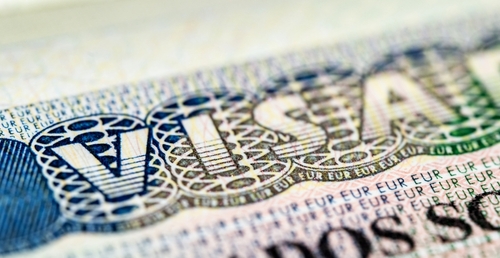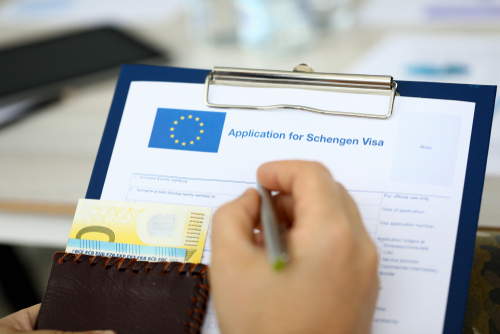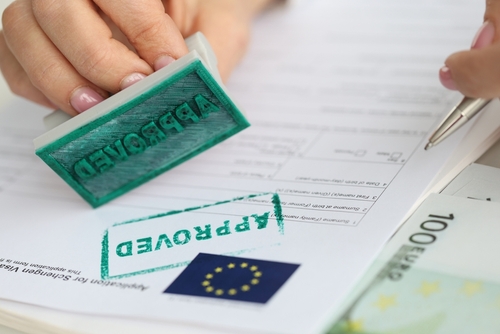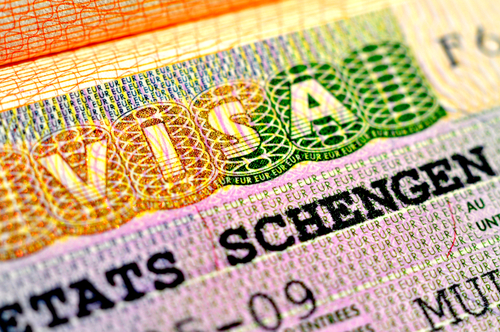If you’re planning to travel to Europe, understanding the Schengen Visa—the short-stay visa that lets you visit 29 European countries with just one application—is essential knowledge for any traveller. As one of the world’s most valuable travel documents, the Schengen Visa allows you to travel freely across borders without repeated passport checks, saving time and making your journeys smoother.
It’s normal to feel a bit overwhelmed by the visa application process, especially if it’s your first time. From gathering documents to making appointments, there is a lot to think about. But with the right preparation, applying becomes much more manageable.
In this Remitly guide, we’ll walk you through each step so you can approach your Schengen Visa application with confidence.
What is the Schengen Visa?
The Schengen Visa is a short-stay permit that allows you to move across 29 European countries without border checks, similar to travelling between different regions of a single, large country.
Not all EU countries are part of Schengen—Cyprus is one example. A Schengen Visa only allows travel within Schengen countries.
The Schengen area countries
The Schengen area comprises 29 countries: 25 European Union Member States and four non-EU countries.
EU members
- Austria
- Belgium
- Bulgaria (as of January 1, 2025)
- Croatia
- Czech Republic
- Denmark
- Estonia
- Finland
- France
- Germany
- Greece
- Hungary
- Italy
- Latvia
- Lithuania
- Luxembourg
- Malta
- Netherlands
- Poland
- Portugal
- Romania (as of January 1, 2025)
- Slovakia
- Slovenia
- Spain
- Sweden
Non-EU members
- Iceland
- Liechtenstein
- Norway
- Switzerland

Types of Schengen Visas explained
The purpose of your visit determines which short-term Schengen Visa you’ll need to apply for.
| Visa type | Purpose | Validity period | Entries allowed |
| Tourist (Type C) | Holidays, family visits | Up to 90 days in any 180-day period | Single or multiple |
| Business (Type C) | Conferences, meetings, trade fairs, events | Up to 90 days in any 180-day period | Single or multiple |
| Transit (Type A) | Airport stopover before continuing to a non-Schengen destination | Up to 1-2 days | Single or multiple |
Single vs. multiple entry
A single-entry visa allows you to enter the Schengen area once. If you leave, your visa expires, even if you still have days left.
A multiple-entry visa allows you to enter and leave multiple times during the validity period. This is useful for travel that requires re-entry.
Embassies may ask for your itinerary, so make sure to apply for the entry type that matches your travel plans.
Who needs a Schengen Visa?
Whether or not you need a Schengen area visa depends on your nationality and residence status.
- Visa-required countries: Citizens of countries including India, China, Nigeria, Pakistan, and Russia must apply for a Schengen Visa in advance.
- Visa-exempt countries: Citizens of the US, Canada, Australia, Japan, and the UAE can visit Schengen countries for up to 90 days within a 180-day period without a visa.
- UK citizens post-Brexit: UK passport holders don’t need a visa for stays up to 90 days within 180 days. For longer stays to study, work, or live, a national visa from the specific country is required.
- UK residents with an eVisa: If you hold an eVisa for residence in the UK but are not a British citizen, you must apply for a Schengen Visa if your passport is from a visa-required country.
Starting late 2026, the European travel information and authorisation system (ETIAS) will require citizens of visa-exempt countries to complete an online entry form before travel.
For the most up-to-date list of Schengen Visa-required and visa-exempt countries, check the European Commission’s official visa policies.
Essential Schengen Visa requirements and documents
When applying for a Schengen Visa, you’ll need to prepare specific documents:
- Valid passport: At least three months’ validity beyond the day you leave the Schengen area. Some countries may also require the passport to have been issued within the last 10 years and/or to have at least two blank pages.
- Completed Schengen Visa application form: Complete it carefully and make sure it matches your supporting documents.
- Passport photos: Usually 35x45mm, taken within the last six months
- Travel insurance: Minimum coverage of €30,000 EUR (about £26,000 GBP), including emergency medical care, hospitalisation, and repatriation. The policy must cover your entire stay.
- Proof of accommodation: Hotel bookings, invitation letters, or rental agreements
- Flight itinerary: Reservation showing return or onward travel. This does not need to be a confirmed ticket; in fact, some consulates warn against buying tickets before a visa is issued.
- Financial proof: Bank statements, payslips, or sponsorship letters showing sufficient funds for daily expenses (typically €50-120 per day, but the exact amount depends on the country)
- Purpose-specific documents: If travelling for business, provide conference invitations or company letters. If visiting family, share an invitation letter and proof of relationship.

How to apply for a Schengen Visa
Following these steps helps you stay organised and avoid delays.
1. Choose the right embassy or consulate
Apply for your visa at the embassy of the country where you’ll be spending the majority of your trip. For example, if you’re staying 10 days in France and five days in Portugal, apply through the French consulate. If you plan to stay an equal number of days in multiple countries, apply with the first country you will visit.
If your trip has a layover outside the Schengen area, check if you will also need a separate airport transit visa.
2. Book your appointment
It’s best to schedule your appointment two to eight weeks in advance, as appointments can book quickly during peak travel times, like summer and holidays. You can apply through the official embassy website or an authorised centre, like VFS Global.
If no appointments are available, check first thing in the morning for new slots.
3. Complete your application
Complete your Schengen Visa application (usually available online) carefully to ensure accuracy and consistency with documents.
You should also avoid vague answers. Instead of “staying with a friend,” list the friend’s full name, address, and relationship to you.
4. Attend your appointment
Bring both originals and copies of your documents. Appointments typically last about 15-30 minutes, but allow extra time in case of queues.
During the appointment, the officer may ask questions like “What is the purpose of your visit?,” “Who will you be staying with?,” and “How will you finance your trip?”
If you are a first-time applicant, the officer will also take fingerprints and photos. Children under the age of 12 are exempt from having their fingerprints taken.
5. Track your application
Use your application reference number to monitor your application status online. Schengen Visa processing time is usually 15 days, but it can take up to 45 days if extra checks are needed.
Schengen Visa costs
Currently, the visa fee is €90 (£78) for adults and €45 (£39) for children aged 6-12. For applicants from Armenia, Azerbaijan, and Belarus, the fee is €35 (£30), while it’s €67.50 (£59) for applications from Cabo Verde.
The visa fee may be waived for applicants under six years old, students, researchers, non-profit participants, and the families of EU/EEA citizens.
Additional service fees may apply if you apply via a visa service centre.
Tips for a successful application
Applying for a Schengen Visa involves more than filling out forms. Paying attention to details helps you feel more confident about your application.
- Double-check requirements: It can help to review the latest embassy guidance before your appointment. Common reasons for rejection include missing documents or insufficient proof of funds.
- Over-prepare: Bring extra copies of supporting documents, such as bank statements or proof of previous travel.
- Interview prep: Be honest, concise, and consistent with your documents and travel plans.
- Track progress: Regularly check your status so you have time to reapply or appeal if needed.
- Organise your itinerary. A simple, logical travel plan helps demonstrate preparation and intention to return.

What happens after approval
Once approved, you’ll receive your passport back with the visa inside. Check validity dates, number of entries, and duration of stay. If something looks incorrect, contact the embassy before you travel.
Border entry checks
Border officers sometimes ask for proof of accommodation, travel insurance, funds, and return tickets–even with a valid visa. Having these documents ready can make your border entry smoother and less stressful.
From 12th October 2025, the EU will begin introducing a new Entry/Exit system (EES) for all short-stay entries, and officers will take fingerprints and photographs upon entry. This gradual rollout may lead to longer queues at some border crossings.
Changing travel dates
Schengen Visas cannot usually be amended once issued. If your travel plans change significantly, you will likely need to apply again with updated documents. For small changes, such as adjusting flights by a few days within visa validity, you can normally continue with your existing visa.
Extending your visa
Extending a Schengen Visa is rare and is only granted for medical emergencies, force majeure, or humanitarian reasons.
You can request an extension by applying to the immigration authority in the country you’re currently staying in before your visa expires, and providing any supporting documents.
Troubleshooting common issues
Despite best efforts, challenges can arise. Here’s how to handle them calmly and effectively.
- Application rejected: Carefully review the reason given by the embassy and reapply with corrections. If you believe the decision was unfair, you can also appeal the decision within the given timeframe (the specific process will depend on the country you applied to).
- Delayed processing: Most applications are processed within 15 days, but delays can happen. If processing exceeds 45 days, contact the embassy or VFS Global centre to request an update.
- Lost passport: If your passport is lost or stolen, apply for a new one with your home country’s authorities and let the Schengen embassy know. You will likely need to reapply for the visa.
- Emergency travel: Some embassies may expedite urgent cases, such as family emergencies. You will need to provide proof of the emergency (medical certificate, funeral notice) and may need to pay additional fees.
Your journey to Europe starts here
Applying for a Schengen Visa takes preparation, but many travellers navigate the process successfully each year. After determining your need for a visa, carefully gather all documents, apply through the correct embassy, and stay organised and patient. With the right preparation, you’ll be ready to enjoy your travels across Europe with confidence.
FAQs
How early can I apply for a Schengen Visa?
You can apply for a Schengen Visa up to six months before your trip. The latest you can apply is 15 calendar days before travel. Leaving it to the last minute can be risky as appointments fill up quickly and processing times vary by season and location.
Can I work with a tourist Schengen Visa?
No, only leisure, family visits, or short business activities are allowed on the Schengen Visa. If your goal is to work, study, or live in a Schengen country, you’ll need to apply for a national visa or residence permit specific to that country.
What if I want to extend my stay while in Europe?
Schengen Visas are typically valid for up to 90 days within a 180-day period, and extensions are only granted in exceptional cases. You may request an extension by applying to the immigration authority in the country where you are staying before your current visa expires.
Do I need travel insurance for the duration of the entire trip?
Yes, it’s mandatory to have an insurance policy that covers you for the entire length of your stay and in all the countries you will visit. Your insurance must include at least €30,000 EUR (about £26,000 GBP) in coverage for medical emergencies, hospitalisation, and repatriation.
Can I apply for a Schengen Visa if I have a criminal record?
It depends on the type and severity of the offence. A minor conviction, such as a small traffic fine or non-violent misdemeanour, does not usually prevent approval. However, more serious crimes may affect your eligibility. Each application is reviewed individually, and the final decision rests with the consular officer.
What happens if I overstay my Schengen Visa?
Depending on the country and length of overstay, you may face fines, an official entry ban, or difficulty applying for visas in the future. If an emergency prevents you from leaving on time, contact local immigration authorities immediately to explain your situation.
Can I enter through a country different from the one stated in my application?
Yes, the visa allows you to enter through any Schengen country, even if you applied through a different embassy. For example, if you applied through the French consulate, but found a cheaper flight to Germany, you can still land there first. What matters more is that you spend the majority of your trip in the country where you applied.
